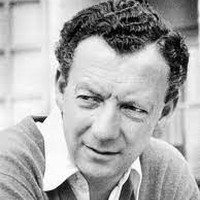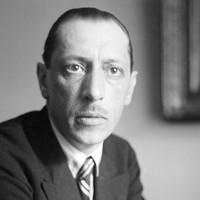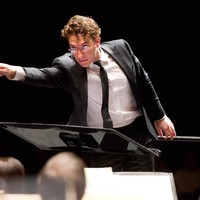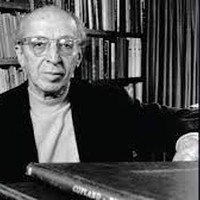Simple Symphony and Fancy Fiddling



Benjamin Britten had a precocious start in music, studying piano and viola and composing hundreds of works by the time he was a teenager. At 14, Britten’s viola teacher introduced him to the composer Frank Bridge, who agreed to give Britten private lessons. The ambitious composer lost some of his youthful swagger working with Bridge—he later wrote, “I, who thought I was already on the verge of immortality, saw my illusions shattered”—but he emerged from the demanding lessons with new rigor and technique to match his natural inventiveness.
Britten entered the Royal Conservatory of Music in 1930. His composition lessons there with John Ireland were unremarkable, far less influential than his discoveries of modern composers ranging from Schoenberg to Stravinsky. Britten’s career gathered steam in 1932 when a prize-winning Phantasy for string quartet led to his first professional performance. A Sinfonietta from the same year became his official Opus 1.
The Simple Symphony cataloged as Britten’s Opus 4 had its roots in his juvenilia. The four movements recycled eight themes he wrote between the ages of nine and twelve, as he explained in a program note. “Although the development of these themes is in many places quite new,” he wrote, “there are large stretches of the work which are taken bodily from the early pieces.”
This work for string orchestra plays with baroque and classical conventions, in the manner of Prokofiev’s “Classical” Symphony or Stravinsky’s many neoclassical scores. The first movement, titled Boisterous Bourrée, adapts the tempo and phrasing of that French dance, while Playful Pizzicato aptly describes this all-plucked, scherzo-like romp. The slow and stately pace of the Sentimental Saraband again updates a time-honored French dance. In the Frolicsome Finale, drawn-out crescendos and colorful contrasts hark back to the rollicking rondos of Haydn and Mozart.
Aaron Grad ©2017
In Pursuit of Flying is a piano concerto in three movements, all of which are connected thematically and structurally. The first movement features material that is clearly melodic in nature, and plays with the traditional form of a first movement for concertos. The first theme is introduced in the orchestra, and the piano introduces the second theme when it enters, so that the ensemble and piano are delineated not only dramatically but thematically as well. The piano later picks up the first theme, and then following its cadenza, both themes are combined.
The second movement is a dream-like exploration of dovetailing harmonies and themes. Unresolved dissonances are allowed to trail off into silence until a second character emerges--a kind of gentle dance which lives in a world that weaves freely into and out of the slower more emotionally charged music. The piano has the last word, after one final outcry which roars with blurred dissonances: a slow cadenza made up of long suspensions counterpointing a transformation of the opening melody. The final movement is a wild and spinning presto with ripping figures in the piano, romping through the ensemble and finally careening towards an explosive end.
I am thrilled to have written this concerto for Jeremy Denk, who is one of my all-time favorite pianists. To write this piece for Mr. Denk and The Saint Paul Chamber Orchestra is truly an honor. And I am profoundly grateful to Justus and Helen Schlichting for generously commissioning the piece.
Hannah Lash ©2017

“I wrote this piece originally for a five-piece group consisting of fiddle, two guitars, piano and double bass. It began one day when I was inspired to pick up my fiddle and push record on my phone, seconds after returning home from a run in Prospect Park in Brooklyn, where I live. I was literally still sweating in my shorts and t-shirt but I felt inspired, so that was it. I had a great time improvising ideas for about 30 minutes—but all the material I needed for Pando turned out to be in the first 1-½ minutes. I didn’t understand that at first; I was working with too many ideas for a few days until I realized it was just too much to fit into my target 5 to 6 minute instrumental. So there’s a Big Fiddle 2 [original title Big Fiddle] lurking in my Pro Tools [recording software] now, full of good ideas I couldn't fit into this piece.
“I often like to write by layering parts in Pro Tools and later notating; even for a lot of counterpoint, it usually works; and so I played the guitar, piano, fiddle and even bass part (by pitch-shifting my viola – I don’t play bass). One and a half minutes of improvising was followed by many days and late nights to flesh out the materials. The process feels organic and I love it; I imagine it’s how sculpting feels, one tiny step at a time.
“My intention for the piece was to hit this cross-section of pulse vibe, beautiful full string sounds, old-time Appalachian fiddle: a sound of innocence and minimalism. There’s a kind of trancelike minimalism that happens naturally in great old-time fiddle and banjo music, with the tune happening again and again, and you’d be fine listening to it forever. The piece uses that approach for shorter moments, for example, underneath a solo improvisational section. The name was a working title referring to the epic quality and the use of the double bass —but it seems to be sticking.”
Jeremy Kittel ©2017

Teddy Abrams was born in 1987 in Oakland, CA, and currently resides in Louisville, KY. His work Fiddling was composed in 2015 for the Indianapolis Symphony where it was premiered in September of that year with the composer conducting. The work is scored for strings.
American composers have been exploring the relationship between folk, popular and “classical” music since the earliest musical works were written in this country. Our nation has developed a remarkably rich and diverse range of popular musical styles, and composers of orchestral music have found inspiration in connecting with the energy and expressive qualities of these traditions. The American fiddling genre, a broad family of styles ranging from pure Bluegrass to Old Time and “Newgrass” music, has always been inspiring and beautiful to me, both for its musical elements and the cultural significance of its role in entertaining and providing an aural history of this nation.
When a “classical” composer draws from this tradition it can take the form of a direct quote of the fiddling repertoire, as Aaron Copland does in his ballets Rodeo and Billy the Kid, or it can evoke the sensation or sentiment of the music. I engaged the latter technique; rather than reference an existing tune, I’ve created my own bluegrass-styled work that uses American fiddling energy alongside contrapuntal and harmonic components drawn from my own background in classical music. This work is also a tribute to a very meaningful and nostalgic period of my life when I spent three summers in the mountains of Western North Carolina learning to play our Old Time fiddling music, an experience that left me with a lasting appreciation for this music’s sonic power and role in bringing together American communities.
Teddy Abrams ©2017

A Brooklyn-born, French-trained son of Russian-Jewish immigrants, Aaron Copland gave voice to America’s rural life and landscapes like no classical composer before or since. After El Salón México, a campy orchestral score from 1936 inspired by Copland’s first trips south of the border, he followed up with the ballet Billy the Kid from 1938, which incorporated quotations of cowboy songs and Mexican folk tunes. His next ballet, Rodeo, returned to the southwest to depict a Saturday afternoon rodeo and a Saturday night dance, along with all the courtship rituals involved in such a gathering of young people on a rural ranch. As in Billy the Kid, Rodeo incorporated traditional music. The main theme of the rollicking Hoe-Down came from the fiddle tune Bonaparte’s Retreat as recorded by the audio archivist Alan Lomax in 1937, capturing the rendition of a Kentucky fiddler named William H. Stepp.
Aaron Grad ©2017
Get driving directions and find nearby parking.
Find dining options close to the venue.
View seating charts to find out where you'll be seating.
Get driving directions and find nearby parking.
Find dining options close to the venue.
View seating charts to find out where you'll be seating.
